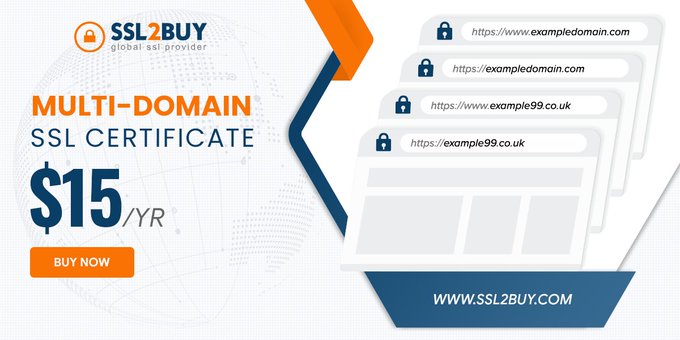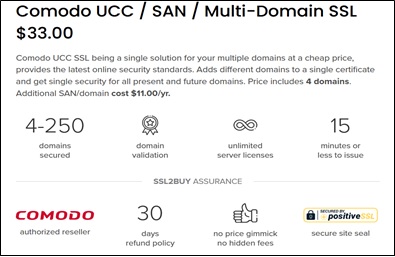Multi-Domain SSL – SSL (Secure Socket Layer) certificates are digital security solutions that help in securing electronic data. It commences from securing data communication between the client and the server with encryption to increasing user trust and enhancing SEO (search engine optimization); SSL certificates are crucial for all types of companies.
Whether it’s a small blog or a huge e-commerce site, SSL certificates are necessary to prevent data breaches and hacker attacks.
But the question is:
- If you have multiple websites, how will you secure them?
- Do you need to purchase various SSL certificates for each site for securing the domains and sub-domains?
- How to manage multiple SSL certificates? Won’t it be time-consuming and difficult to manage?
Many digital owners think the wrong way, i.e., they think that the more the sites you need to be secured, the more SSL certificates you will require.
The above statement is false since you will not need multiple SSL certificates for multiple websites. One single Multi-domain SSL certificate is sufficient for securing all your sites.
Table of Contents
About Multi-Domain SSL Certificates:
Multi-Domain SSL certificates, preferably named SAN (Subject Alternate Name) SSL certificates secure multiple hostnames with a single SSL certificate, i.e., multiple domains and all sub-domains of varied levels are secured with this single SSL certificate.
The Certificate Authority (CA), which issues this SSL certificate, decides on the count of domains that can be secured. Depending on the CA, generally, one single multi-domain SSL certificate can secure up to a maximum of 250 domains.
The Common Name (CN) indicates the root/primary domain, whereas all the other domains are SAN domains. These SAN domains can either be other domains or various sub-domains.
Example:
Jack has various businesses and has multiple sites for the same. He needs domain security for all his sites, and the only security solution for the same is to install a Multi-domain SSL certificate.

He can secure all the sites as shown in the above image, where www.exampledomain.com will be stated in the CN, whereas the rest will be termed as SAN domains in the CSR form while requesting the Multi-domain SSL certificate.
Comodo Multi-Domain SSL certificate from SSL2Buy secures up to 250 domains and costs $33/year.

In case you select a Multi-domain Wildcard SSL certificate:
- It will secure multiple Fully Qualified Domain Names (FQDN)
- Varied IP addresses
- Multiple hostnames
- Varied payment gateways
Since these SSL certificates come with unlimited server licenses, they can also secure domains present on multiple servers.
Go for a Multi-domain Wildcard SSL certificate from SSL2Buy, which includes dual-domain security and the addition of up to 100 basic SANs and 100 Wildcard SANs costing a mere amount of $15/year.
Features/Benefits of Multi-Domain SSL Certificate:
- 256-bit Encryption
- Unlimited Server Licenses & SSL Reissuances
- Warranties & Money-back offers
- Clickable Site Seal
- Inclusive of all Organisation Details
- Functioning with all Popular Browsers, Mobiles, and Other Devices
- Cost-friendly and Easily Manageable
- Availability in all Validations (DV, OV & EV)
- Inclusive of SSL Configuration Checker Tool for checking the configuration of the SSL certificate
How do SSL certificates ensure Comprehensive Security for Websites?
The Functioning of SSL certificates:
- The functioning of SSL certificates commences once the user’s browser (client) connects with a website secured with an SSL certificate.
- An SSL handshake process commences, ascertaining that the encryption/decryption is taken properly. In short, it verifies that the coding and decoding of the data are carried out smoothly.
- The client later sends a request to the server, which sends a copy of the SSL certificate to the browser.
- Once received, the browser checks the certificate validation, and if found trustworthy, it will send a message to the server to acknowledge the same.
- Post acknowledgment from the client, an encrypted connection is established between both parties. The browser uses its public key, and the server uses its private key to begin this encrypted session. This is a secure communication that takes place between both parties.
- Encryption converts all the plain data into ciphertext (gibberish language making it non-readable). The browser does the same for communicating its message to the server.
- This encrypted communication passed between the browser, and the server is secured from hackers.
The Functioning of Multi-Domain SSL Certificates:
An SSL certificate request is made by generating the CSR (Certificate Signing Request).
In the case of Multi-domain SSL certificates, the domain name will be written in the common name (CN) field, and other domains/sub-domains will be written in the SAN fields in the CSR form.
Remember: SANs are secured with the same strong encryption as the CN.
When the browser visits a site secured with a multi-domain SSL certificate, firstly, it will check the certificate validity. Then, it will also match the URL with its list before commencing a secure connection with the server.
SSL Validations:
Different validations secure the web in different ways.
The Domain Validated certificate(DV SSL) is the most common and low-budget certificate which can be issued quickly. The CA verifies the domain name with the WHOIS record and checks the ownership of the same.
After confirming domain rights, the CA issues this DV SSL (Domain Validated certificates)certificate, which helps secure individual blog sites and other sites.
In the case of Multi-domain SSL certificates, verification of the Domain and the organization ownership is necessary, and hence they require an Organization Validated (OV) SSL certificate. This ensures the customers that the company site they visit is trustworthy since it has its details mentioned in the certificate.
The highest authentication level stands for Multi-domain Extended Validated (EV) SSL certificates since it displays trust icons like dynamic site seals on the domains and sub-domains secured by it.
It is the epitome of trust, authenticity, and integrity for your site and business.
Tip: To gain maximum SSL security for your site domains and sub-domains and provide the highest level of trust and security assurance to your customers, select Multi-domain SSL with an organization validation or an extended validation.
Beware of Sharing the Private Key:
Installing a single SSL certificate on varied servers involves risk. The reason is that the sharing of an SSL certificate on multiple servers requires the sharing of the private key also.
Hence, if the private key is compromised, it may impact all the servers linked with that key. Therefore, to ensure the maximum level of security, avoid sharing the private key.
Wrapping Up:
Large corporates and medium-sized industries, business owners having multiple sites, who prefer to use Multi-domain SSL certificates for their site security.
Providing robust 256-bit encryption and 2048-bit key length, SAN support and a dynamic site seal for trust, this Multi-domain SSL certificate is budget-friendly and easy to manage and hence the most desirable amongst digital owners.


